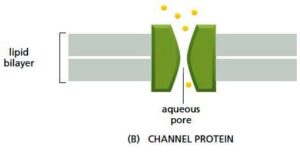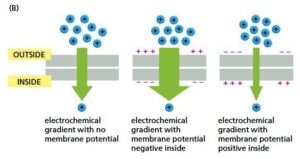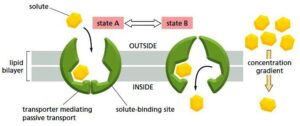Membrane Transport and its Types – Passive and Active Transport and its Transporters
Introduction
- Membrane lipid bilayers have a hydrophobic interior, which prevents the passage of most polar molecules.
- The barrier function of lipid bilayer permits maintenance of concentrations of solute in its cytosol which differ from the extracellular environment.
- Cells have evolved the mechanisms to carry water-soluble molecules and ions across the membranes to perform essential functions like ingesting essential nutrients, excreting metabolic waste products, and regulating intracellular ion concentrations.
- Cells use special transmembrane proteins which carry small water-soluble organic molecules to navigate through the bilayer.
- Lipid bilayer permits hydrophobic molecules to cross the membrane, which includes steroids hormones, gases only O2 and CO2, small polar uncharged molecules like ethanol and H2O, by the means of passive diffusion, whereas charged molecules of any size which includes amino acids and small ions such as H+, Na+, K+, Ca+ requires membrane proteins to perform the transport.
- The two dominating classes of membrane proteins which are in charge of the movement of molecules across the bilayer- a transporter, serves as a vehicle to carry specific molecules crossing the bilayer and channels, which forms narrow pore exists as hydrophilic and favors the passage of water and small inorganic ions.
- The passive transport is facilitated by diffusion against the concentration gradient (from higher concentration to low concentration).
- The active transport is carried out by transporters, which mediate the transfer of solutes, coupled with a source of energy.
Membrane transport works on the following principles
- The bilayer is impermeable to ions- It is stated that uncharged non-polar molecules such as oxygen and carbon dioxide diffuse faster as compared to small uncharged polar molecules like water or urea. But bilayer is highly impermeable to charged ion molecules which include Na+ or K+ irrespective of their small size because of hydration and charge of the molecule; they are not able to enter the bilayer.

- Membrane transport is carried out by two major classes of protein– Transporters and channels.
- To mediate transfer of polar molecules which includes ions, sugar, amino acids across the bilayer, perform by transporters, a specialized membrane protein.
- The transporters are also named as carriers or permeases, it functions by interacting with specific solute, and experience chain of conformational changes for the transfer of bound solute to cross the bilayer.
- In contrast, Channels form a pore that is hydrophilic in nature and favors the passage of specific solutes which include inorganic ions, water ( transfer is carried out by aquaporins or water channels).
- The transport mediated by channels is much faster than transport carried out by transporters.


Overview of Active and Passive Transport
- Most of the transporters and channels allow uncharged solutes to diffuse passively; this process is known as passive transport or facilitated diffusion. It depends on concentration gradients across the membranes on the basis that the direction of flow is determined. Diffusion is mostly downhill i.e., from high concentration to low concentration.
- In the case of charged molecules, transport is mediated by active transport. The charge present on molecules drives electrical potential difference across the cell membrane. Both concentration gradient and electrical gradient combine to generate a driving force, which is called electrochemical gradient.
- The transport protein pumps certain solutes opposing their electrochemical gradient, it is carried out by process is termed as active transport, and it is usually coupled with metabolic energy like ATP hydrolysis.


Mechanisms used in Passive Transport and Active Transport carried out by Transporters
- The process that the transporter carries out, is very similar to enzyme-substrate reaction, in most ways the transporter acts like an enzyme but it delivers the bounded solute unchanged while crossing the bilayer.
- All individual transporters have specific sites for binding the solute, which serves as a substrate, during the process to transfer solute which crosses the bilayer, the transporter undergoes conformational changes which are reversible.

- Kinetics of Transporter mediated diffusion comparison with the simple diffusion- In simple diffusion; the rate of transport is directly proportional to the concentration of the solute whereas, in transporter-mediated transport, the rate of diffusion is at maximum when the transporter is saturated which means all solute binds to the solute binding sites of the transporter. The rate is mentioned as Vmax, the binding constant of the transporter binding the solute (Km) is equal to the solute concentration when the rate of transport is half its maximum value.

- For active transport of the solutes, the transporter is usually coupled with a source of energy to act up against the electrochemical gradient of the plasma membrane, which includes ATP hydrolysis or ion gradient.
- Active transport is carried out by mainly three types of transporters
-
- Coupled- Transporters are coupled with the transport of one solute with a second solute, basically, it is depended on each other for their transport.
- ATP- driven Pumps, are coupled with a metabolic energy source for e.g., ATP hydrolysis.
- Light-Driven Pumps are coupled with light energy, it is commonly found in archaea, bacteria.

Types of Transporters used in Active Transport
There are three types of movements carried out by transporters
- The transport of the one solute which crosses the bilayer is carried out by transporters, the rate is usually determined by Vmax and Km. It is called Uniporters.
- Some transporters work as coupled transporters, by which transfer of one solute is carried out by accompanied transfer of the other solute, if both solutes are carried in a similar direction, transport is done by Symporters, also known as co-transporters.
- If both solutes are transferred in opposite direction during coupled transport, it is carried out by Antiporters, which is also named as exchangers.

Types of movements carried out by transporters
- Active Transport can also be carried out by ion gradients- Coupled transporters need to harvest energy, from an electrochemical gradient to carry out the transport of the solute. The mobility of inorganic ions releases free energy, which acts as a driving force to pump out the solute opposing its electrochemical gradient. The mobility of the solutes can be in the opposite direction or in the same direction which is carried out by coupled transporter; it can perform as symporters or antiporters.
- In the membrane of animal cells, the co-transporter ion is usually Na+, it enters the cells during transport and is pumped out from the plasma membrane by ATP- driven Na+ pump which helps to maintain the Na+ gradient and indirectly carries out the transport.
- ATP- driven carriers carry out the primary active transport though ion-driven carriers carry out the secondary active transport.
- ATP- driven pumps are classified into three classes
-
- ATP- driven pumps are called transport ATPases, the energy is obtained to carry out the transport by hydrolyzing ATP to phosphate and ADP.
These three main classes of ATP- driven pumps are found in various types of cells including prokaryotes and eukaryotes:
-
- P-Type Pumps- It is very much common to the transmembrane proteins, both structure-wise and function-wise. P-Type pumps are named because during the pumping cycle, it phosphorylates. It includes majorly ion pumps, responsible to maintain ion gradients across the membranes which include Na+, K+, H+, and Ca+.
- F- Type Pumps is composed of the different subunit of protein resembles the working of the turbine. It is found in the plasma membranes of bacteria, mitochondria, and chloroplasts. It is also named ATP Synthases, it produces ATP with the help of ADP and phosphate by using H+ ion gradient usually generated by electron transport or photosynthesis across the membranes.
- ABC Transporters- It exclusively transports small molecules in contrast with P-Type and F-Type which transport ions.

Reference and Sources
- https://quizlet.com/433702671/bio-unit-3-flash-cards/
- https://www.ncbi.nlm.nih.gov/books/NBK26896/
- https://wou.edu/chemistry/courses/online-chemistry-textbooks/ch103-allied-health-chemistry/ch103-chapter-9-homeostasis-and-cellular-function/
- https://edisciplinas.usp.br/pluginfile.php/5681468/mod_resource/content/1/Aula%2011%20Transporte%20em%20Membranas.pdf
Also Read:
- CRISPR-Cas9 Gene editing tool: Introduction, Principles, Uses & Applications
- Different Types of chromatography
- Classification of viruses on the basis of genome
- Plasma Membrane- Structure, Properties, Lipid Rafts and Glycolipids
- Cold sores : Introduction, Entry, Symptoms, Diagnosis and Cure
- Difference between Prokaryotes and Eukaryotes
- Comparison Between the Domains Bacteria, Archaea, and Eukarya
